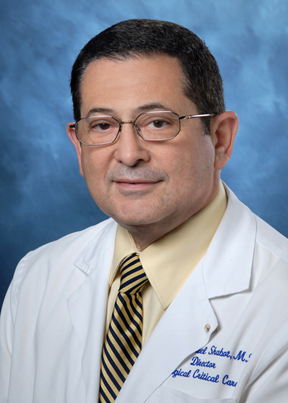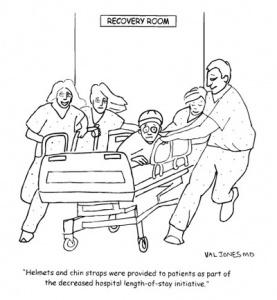December 9th, 2008 by Dr. Val Jones in Audio, Expert Interviews
3 Comments »
 |
|
Dr. Michael Shabot
|
I recently interviewed Dr. Michael Shabot, Memorial Hermann Hospital System’s Chief Medical Officer, about how his hospital is taking steps to improve patient safety and healthcare quality. His hospital was awarded the 2008 National Health System Patient Safety Leadership Award at a ceremony at the National Press Club.
You may listen to your 20-minute interview here, or read my summary of it below.
[Audio:http://blog.getbetterhealth.com/wp-content/uploads/2008/12/shabot.mp3]
Dr. Val: Tell me about what Memorial Hermann has been doing in the area of hospital quality and safety.
Dr. Shabot: We operate Memorial Hermann Healthcare System on the premise that all patients, visitors, and staff will have an absolutely safe environment. In fact, six of our hospitals have gone a year without a single case of hospital-acquired blood stream infections, or ventilator-associated pneumonia.
Larry Kellner, the CEO of Continental Airlines, can travel on any one of his airplanes without checking on the credentials of the pilots. But would you advise a family member to go to a hospital without checking its credentials or being under the care of a physician whom you know and trust? I wouldn’t.
Every single one of our hospital employees has gone through our “cultural transformation” training. They are taught new ways of doing their current jobs – based on safety training with a proven track record in the aircraft and nuclear energy industries. We also feature employees who have “good catches.” Last month’s “good catch” employee found a medication that was packaged incorrectly from the vendor. It was in the correct bin of our computerized dispensing system, the outer package was correct, but the bottle inside contained a different dose. And this medicine was going to be given to a tiny baby in our neonatal ICU. That incorrect dose could have caused terrible harm, but thanks to the alert nurse – we caught the error.
Read more »
December 7th, 2008 by Dr. Val Jones in Audio, Expert Interviews
No Comments »
 |
|
Nancy Schlichting
|
“Detroit is the poorest city in America. But we’re not going to be victims of circumstance. We’re going to rise up and lead the country in healthcare quality and become part of the economic solution for our community. The Henry Ford hospital name must mean something when people drive up to it.”
– Nancy Schlichting, President and CEO, The Henry Ford Health System, Detroit, Michigan
I sheepishly admit to being surprised that a hospital system in Detroit was singled out for a national award for hospital quality and safety. Who would think that the poorest city in America could be a beacon of light in these dark times in healthcare? The story of Henry Ford Health System, and its female president and CEO, Nancy Schlichting, is both inspirational and motivational. I had the chance to interview Nancy at a recent award ceremony at the National Press Club where she received the 2008 National Health System Patient Safety Leadership Award.
You may enjoy our conversation via podcast, but please forgive the “tinny” sound quality. I recorded our conversation with a little hand-held digital device instead of my usual recorded phone line.
[Audio:http://blog.getbetterhealth.com/wp-content/uploads/2008/12/nancyschlichting.mp3]
Dr. Val: Congratulations on winning the National Health System Patient Safety Leadership Award. Has improving patient safety at your hospital been a challenge?
Schlichting: On a given day, a patient may encounter up to 50 different hospital employees. Coordinating our efforts so that the patient’s experience is consistently positive and error-free is certainly challenging.
We have 7 pillars of performance at Henry Ford, and the first is “people.” We like to say that we “have to take care of the people who are taking care of people.” We need to make sure that they have the resources they need, that the processes are in place so they can do their jobs well, and that they get their individual needs met. For example, everyone knows my email address and they can contact me at any time if they’re not getting their problems resolved. I respond to every single email. This creates a culture of openness and responsibility. They know that the person at the top cares about them.
Dr. Val: A prominent community member experienced an unfortunate lapse in communication during his hospital stay, which resulted in compromise of his care, and he eventually died in the hospital. You personally met with his wife and promised her that you’d take the necessary steps to ensure that this never happened again. Tell me more about that.
Read more »
November 8th, 2008 by Dr. Val Jones in Celebrity Interviews, Expert Interviews
8 Comments »
 |
|
Dr. Gawande
|
Kaiser Permanente sponsored a special event in DC today – Charlie Rose interviewed Dr. Atul Gawande about patient safety in front of an audience of physicians. Dr. Gawande is a young surgeon at Harvard’s Dana Farber Cancer Institute, has written two books about performance improvement, and is a regular contributor to the New Yorker magazine. I had heard many positive things about Atul, but had never met him in person. I was pleasantly impressed.
Atul strikes me as a genuinely humble person. He shifted uncomfortably in his chair as Charlie Rose cited a long list of his impressive accomplishments, including writing for the New Yorker. Atul responded:
I’m not sure how my writing became so popular. I took one fiction-writing class in college because I liked a girl who was taking the class. I got a “C” in the class but married the girl.
He went on to explain that because his son was born with a heart defect (absent aortic arch) he knew what it felt like to be on the patient side of the surgical conversation. He told the audience that at times he felt uncomfortable knowing which surgeons would be operating on his son, because he had trained with them as a resident, and remembered their peer antics.
Atul explained that patient safety is becoming a more and more complicated proposition as science continues to uncover additional treatment options.
If you had a heart attack in the 1950’s, you’d be given some morphine and put on bed rest. If you survived 6 weeks it was a miracle. Today not only do we have 10 different ways to prevent heart attacks, but we have many different treatment options, including stents, clot busters, heart surgery, and medical management. The degree of challenge in applying the ultimate best treatment option for any particular patient is becoming difficult. This puts us at risk for “failures” that didn’t exist in the past.
In an environment of increasing healthcare complexity, how do physicians make sure that care is as safe as possible? Atul suggests that we need to go back to basics. Simple checklists have demonstrated incredible value in reducing central line infections and surgical error rates. He cited a checklist initiative started by Dr. Peter Pronovost that resulted in reduction of central line infections of 33%. This did not require investment in advanced antibacterial technology, and it cost almost nothing to implement.
Atul argued that death rates from roadside bombs decreased from 25% (in the Gulf War) to 10% (in the Iraq war) primarily because of the implementation of check lists. Military personnel were not regularly wearing their Kevlar vests until it was mandated and enforced. This one change in process has saved countless lives, with little increase in cost and no new technology.
I asked Atul if he believed that (beyond check lists) pay for performance (P4P) measures would be useful in improving quality of care. He responded that he had not been terribly impressed with the improvements in outcomes from P4P initiatives in the area of congestive heart failure. He said that because there are over 13,000 different diseases and conditions, it would be incredibly difficult to apply P4P to each of those. He said that most providers would find a way to meet the targets – and that overall P4P just lowers the bar for care.
Non-punitive measures such as check lists and applying what we already know will go a lot farther than P4P in improving patient safety and quality of care.
Atul also touted the importance of transparency in improving patient safety and quality (I could imagine my friend Paul Levy cheering in the background). In the most touching moment of the interview, Atul reflected:
As a surgeon I have a 3% error rate. In other words, every year my work harms about 10-12 patients more than it helps. In about half of those cases I know that I could have done something differently. I remember the names of every patient I killed or permanently disabled. It drives me to try harder to reduce errors and strive for perfection.
Atul argued that hospitals’ resistance to transparency is not primarily driven by a fear of lawsuits, but by a fear of the implications of transparency. If errors are found and publicized, then that means you have to change processes to make sure they don’t happen again. Therein lies the real challenge: knowing what to do and how to act on safety violations is not always easy.
 |
|
Charlie Rose
|
Charlie Rose asked Atul the million dollar question at the end of the interview, “How do we fix healthcare?” His response was well-reasoned:
First we must accept that any attempt to fix healthcare will fail. That’s why I believe that we should try implementing Obama’s plan in a narrow segment of the population, say for children under 18, or for laid off autoworkers, or for veterans returning from Iraq. We must apply universal coverage to this subgroup and then watch how it fails. We can then learn from the mistakes and improve the system before applying it to America as a whole. There is no perfect, 2000 page healthcare solution for America. I learned that when I was working with Hillary Clinton in 1992. Instead of trying to fix our system all at once, we should start small and start now. That’s the best way to learn from our mistakes.
August 16th, 2008 by Dr. Val Jones in Health Policy
5 Comments »
No one wants to become infected during their hospital stay. Unfortunately it’s not possible to guarantee that it won’t happen. Bacteria are everywhere. We carry them on our skin, in our bodies (especially our digestive tract), and they live in food, clothing, and anything we touch. When we undergo surgery, we cut through the skin/blood barrier that keep the bacteria out, making us vulnerable to inadvertent invasion.
There are ways to reduce the risk of infection (sterile surgical technique, appropriate wound care, and personal hygiene) but the risk is not zero. For the risk to be zero, one would have to begin with a “sterile” patient – a patient who carries no bacteria on or in their body. Since that will never happen, I’m afraid that hospital acquired infections are here to stay.
However, with government-sponsored health insurance programs on the brink of bankruptcy, decreasing expenditures is a high priority. Therefore, Medicare is suggesting that there are certain events that should never happen in the hospital and that they will no longer compensate hospitals for care associated with these events. Although I certainly agree that operating on the wrong body part is appropriately classified as a “never event,” the list has become so long that it includes things that cannot possibly be prevented in all cases (things like catching a cold, developing a blood clot, falling, or becoming infected).
What will result from listing infections as a “never event?” Will it encourage hospitals to improve their infection control processes? Maybe. But here’s what I imagine is more likely to happen:
1. More prophylactic antibiotics will be given to patients to reduce the risk of infection, resulting in higher rates of serious drug reactions. Stronger medicine (with broader coverage) will be preferentially selected – further encouraging the development of drug resistant strains of bacteria.
2. Patients who become infected will be transferred to another facility as quickly as possible. The accepting facility will be compensated for the care of the patient since the “never event” didn’t happen at their hospital. Transferring care in the middle of a serious illness increases the risk for other complications, including miscommunications and medication errors.
3. Since Medicare has set the expectation that hospital acquired infections are 100% preventable, anyone who contracts one will be able to sue the hospital. This will deplete the hospitals of their thin operating margins, causing them to cut programs – probably first for the poor and underserved.
4. Additional testing may be done for any surgical admission – nasal swabs (and potentially rectal swabs or urethral swabs) will be used to document the fact that the patient arrived at the hospital colonized by certain bacteria and therefore did not contract a new infection during their hospital stay.
5. Convoluted documentation methods will abound, so that any patient who becomes infected will receive antibiotics for “prophylaxis” and his fevers will be explained as the usual “post-op” central fevers. All staff will be encouraged to carefully document that the patient is being treated prophylactically only, and does not have an infection. In fact, it’s possible that blood cultures will not be drawn so that there will be no documentation of sepsis. Patients who really do have serious infections will receive appropriate care very late (since the first few days will be spent trying to manage the infection without documenting it or identifying the organism). This could paradoxically result in higher death rates.
6. Patients at higher risk for infection (such as those who are immunocompromised – see my research study on risk factors for line infections here) may be passed over for surgical procedures. This risk aversion could negatively impact health outcomes for vulnerable populations (such as cancer patients or HIV+ individuals).
I could go on theorizing, but you get the picture. In my opinion, the “never events” strategy is fatally flawed and will result in excessive litigation, ping-ponging of patient care, over-use of antibiotics, increases in adverse drug events, a rise in multi-drug resistant bacteria, and further reduction of services to the poor. A more reasonable approach would have been to document infection rates at the most hygienic facilities, and offer incentives for others to strive for similar rates.
The “never events” strategy is destined to do more harm than good for patients with hospital acquired infections, though the medical malpractice attorneys may enjoy a new income stream. This is just one more reason why we should never say never.
***
See Buckeye Surgeon’s take on this topic and his coverage of Jerome Groopman’s article for the New Yorker on the rise of drug resistant “super bugs.”
See Dr. Rich’s take on never events here.This post originally appeared on Dr. Val’s blog at RevolutionHealth.com.















